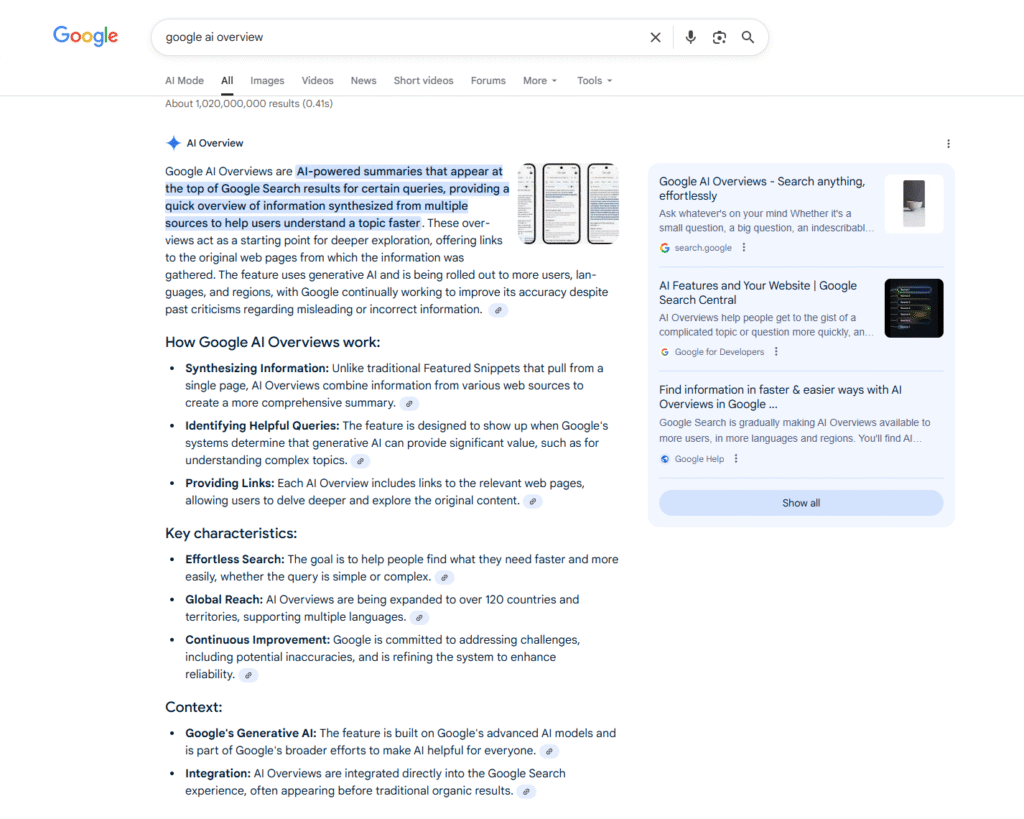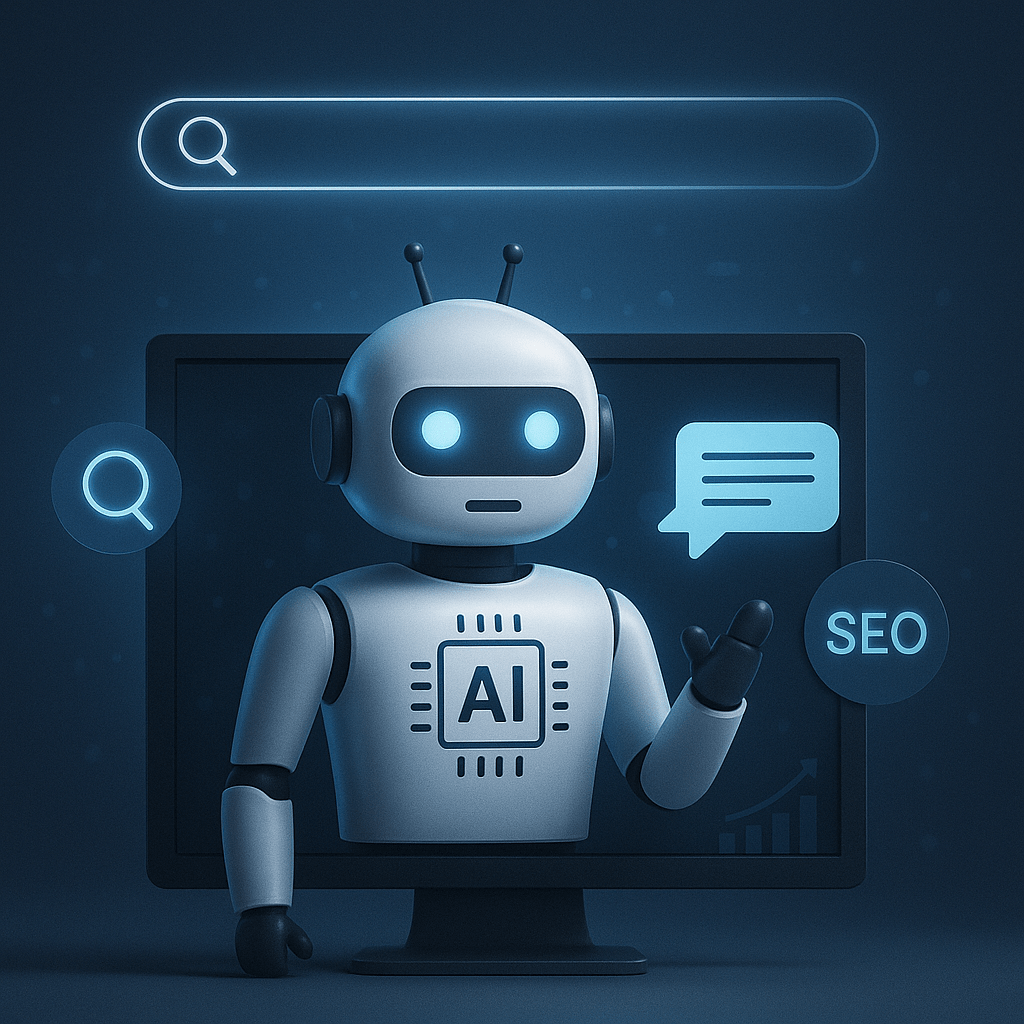Tools like ChatGPT, Perplexity, Copilot, and Google Gemini are becoming the new way users get information, often bypassing traditional search engines altogether.
This article is worth reading because it explains what Answer Engine Optimisation (AEO) is, how it compares to SEO, and most importantly, how you can prepare your business to appear in AI-powered results.
With predictions that AI models will power a quarter of all queries by 2025, this comprehensive guide will give you the strategies you need to adapt to the AI answer engine era.
Table of Contents
What is Answer Engine Optimisation (AEO) and why does it matter in 2025?
Answer Engine Optimisation (AEO) is a natural evolution of search engine optimisation.
Instead of competing for rankings on search engine results pages, businesses must now ensure their content can be selected as a direct answer by AI-driven platforms.
Gartner predicts that by 2026, up to 25% of organic search traffic will shift towards AI assistants, meaning that businesses who fail to adapt risk losing valuable referral traffic.
In 2025, this matters more than ever.
The rise of AI-powered tools means people are no longer just scrolling through lists of links.
They are asking conversational questions, expecting instant results from AI chatbots and virtual assistants, and trusting those answers.
If your brand is not cited in AI, your presence in AI engines could disappear completely.
Answer Engine Optimisation ensures that your content remains part of the conversation, not buried beneath automated summaries created from competitors’ material.
For small and medium-sized businesses in particular, the importance of visibility cannot be overstated.
Local service providers, retailers, and professionals who once relied heavily on organic search now need to adapt to appear in the answers generated by AI engines.
This is not a fad; it is a structural change in how information is delivered online.
How do answer engines work and how are they different from traditional search engines?
Answer engines like ChatGPT, Perplexity, and Copilot are built on advanced AI models.
Unlike traditional search engines, which display a list of websites, these platforms generate conversational responses.
They gather information from multiple trusted sources and deliver concise, direct answers to user queries.
The biggest difference is that answer engines focus on solving the query immediately rather than offering options.
When a user types or speaks a question into a traditional search engine, they are met with a list of results to click through.
With an AI answer engine, the response is generated on the spot, often synthesising information from across AI platforms and citing references.
Google’s AI Overviews are a good example of this in practice.

Rather than forcing users to sift through multiple links, Google presents a combined AI overview, offering a ready-made response drawn from high-quality sources.
This has enormous implications for businesses. Appearing on the first page of Google is no longer enough. You must also ensure that your content is structured in a way that allows it to be featured directly in AI driven results.
Traditional search rewarded long form content, keyword density, and backlinks.
While these still matter, answer engines reward clarity, context, and authority. Being a trusted source with clear structured data now plays a far greater role in determining whether your brand appears in AI search.
What is the relationship between AEO and SEO?
The link between Answer Engine Optimisation and SEO is undeniable. AEO is often seen as a subset of SEO, building upon a solid SEO foundation.
Without strong SEO signals such as technical SEO, backlinks, and a content strategy, it is nearly impossible to achieve visibility in AI.
However, AEO requires additional tactics beyond traditional SEO.
You must use structured data and schema markup to help AI search engines interpret your content accurately.
You also need to create content that delivers direct answers in a clear, authoritative voice.
While SEO has always been about visibility on search engine results pages, Answer Engine Optimisation is about ensuring your brand is mentioned across AI engines.
In other words, SEO ensures your website is visible; Answer Engine Optimisation ensures your expertise is represented.
Together, they form a complete digital marketing approach, supporting both traditional search and AI powered results.
Businesses that treat AEO as an optional extra risk losing ground, while those who view it as a natural extension of strong SEO will gain visibility across AI platforms.
How do ChatGPT and other AI powered tools influence search results?
In 2025, ChatGPT and other AI chatbots are central to how people consume information.
Instead of typing a query into a search engine, users ask questions in natural language.
These AI platforms deliver direct answers, often pulling from authoritative websites and structured sources.
This trend changes the expectations of users. No longer satisfied with scrolling through search results, people expect conversational responses that are concise and accurate.
Brands that want to compete must create content designed for generative AI in search.
That means answering questions directly, being cited in AI, and ensuring information is trustworthy and easy to parse.
The influence of AI search engines is profound.
If a business is consistently mentioned across AI platforms, it gains credibility in the eyes of users. Even when referral traffic is limited, the authority that comes from being a trusted source has long-term benefits.
Strong SEO combined with Answer Engine Optimisation ensures your content appears in responses not just from ChatGPT, but from other AI models as well.
Why Google AI Overviews are a game-changer for digital marketing
Google AI Overviews, also referred to as Google’s AI Overviews, represent one of the most significant changes to search behaviour in decades.
These AI generated summaries appear above traditional search results, condensing multiple sources into one easy-to-read overview.
For businesses, this is a double-edged sword.
On one hand, it provides the opportunity to be placed at the very top of the results page, in a position that attracts instant visibility.
On the other hand, if your content is not included, you risk being pushed further down where users may never see you.
For SEO agencies and SEO consultants, this means adjusting strategies to account for both traditional SEO and Answer Engine Optimisation.
Being present in Google AI Overviews requires more than strong SEO; it requires optimising your content to deliver concise, authoritative, direct answers. It also means implementing structured data and schema markup so Google can extract and display your information easily.
Businesses that ignore this shift risk losing not only organic search visibility but also referral traffic.
Just as Google Business listings once became essential for local visibility, appearing in Google AI Overviews will soon be considered a basic requirement for effective digital marketing.
How to optimise your content to appear in AI search and AI overviews
Optimising for AI search and AI overviews requires a shift in thinking.
First, ensure your site includes structured data and schema markup. This allows AI search engines to interpret your content clearly and identify it as a reliable source for direct answers.
Second, focus on the types of content that AI engines favour.
FAQs, how-to guides, and straightforward explanations are ideal because they can be quickly turned into conversational answers.
Avoid jargon and long-winded explanations. The goal is to provide a trusted source of concise, high-quality information.
Third, position your brand as authoritative.
Build backlinks from respected publications, gain mentions across AI platforms, and become known in your industry for reliable content.
The more you are mentioned, the greater your visibility across AI will be. This requires both creating content and engaging in digital PR efforts to raise awareness of your expertise.
Finally, monitor your progress.
Use tools like OmniSEO or similar AI tools to track where your brand appears in AI responses.
Although tracking Answer Engine Optimisation is still developing, consistent monitoring ensures you refine your content strategy and adapt as AI engines evolve.
What role do Perplexity and Copilot play in AI search engines?
While ChatGPT is widely known, platforms like Perplexity and Copilot are also reshaping the search landscape.
Perplexity is unique in that it always cites its sources.
For businesses, this means that if your site is optimised correctly, you can be directly referenced as a trusted source in Perplexity results. This not only provides search visibility but also increases trust as users see your brand cited in authoritative AI responses.
Copilot integrates AI generated answers directly into productivity tools.
This means that direct answers are being embedded into people’s workflows, making visibility across AI engines even more important.
Appearing in Copilot answers allows your brand to be part of conversations within business and productivity environments, extending your influence beyond search engines alone.
Together, these platforms demonstrate how different AI search platforms are creating multiple opportunities for visibility. Success requires a strategy that considers mentions across AI platforms, ensuring your business is consistently present no matter which AI assistant or tool people use.
How can businesses build visibility across AI platforms and answer engines?
Building visibility across AI platforms requires a multi-layered approach.
Start with a solid SEO foundation, technical SEO, high-quality content, and backlinks remain essential. Without this, your content will struggle to be recognised by AI engines.
Next, focus on creating content that directly answers user queries.
This should be structured with headings, clear explanations, and schema markup. Make sure your content addresses both simple questions and complex topics, so you cover the full range of search queries.
Invest in digital PR and link building to position your brand as a trusted source.
Aim for mentions across AI platforms by contributing guest posts, collaborating with industry partners, and building relationships with journalists and bloggers.
The more your brand is mentioned across AI platforms, the stronger your visibility in AI becomes.
Finally, use AI tools like OmniSEO to monitor your presence in AI engines.
By tracking when your brand is cited in AI, you can measure progress and refine your strategy. Remember, visibility in AI is not a one-time achievement; it requires ongoing effort and adaptation.
What are the benefits of AEO for search visibility and referral traffic?
The benefits of answer engine optimisation are significant.
First, it ensures visibility in AI, which is critical as more users shift from traditional search engines to AI search engines.
Second, being cited in AI builds trust. When users see your brand mentioned in authoritative AI generated answers, they view your business as a trusted source.
Third, Answer Engine Optimisation provides indirect benefits even when referral traffic is limited. Being brand mentioned in an
AI overview or AI answer engine reinforces authority and credibility. This can influence customer decisions, even if they don’t immediately click through to your site.
Finally, Answer Engine Optimisation supports long-term digital marketing efforts.
By building authority and visibility across AI, you strengthen your overall search presence. This complements organic search and ensures that your brand remains competitive as generative AI in search continues to expand.
Practical steps to plan your AEO strategy in 2025
Planning an Answer Engine Optimisation strategy starts with an audit.
Begin by searching for your brand and services in ChatGPT, Perplexity, and Copilot. Note whether your business is cited and what type of content is being referenced.
Next, align your content strategy with common user queries.
Create content that delivers direct answers, uses schema markup, and positions your brand as an authoritative voice. FAQs and how-to guides are especially effective here.
Work with a SEO agency or SEO consultant to strengthen technical SEO and ensure your site is structured properly.
Implement structured data across your site and refine content to improve clarity.
Finally, invest in building relationships that increase your mentions across AI platforms.
This could include partnerships, guest blogging, or industry features. By ensuring your brand is present in multiple places, you build consistent visibility across AI.
Key Takeaways
- Answer engines are replacing traditional search engines as the main way people access information in 2025.
- Answer Engine Optimisation (AEO) is essential to ensure your brand is cited in AI and maintains visibility across AI platforms.
- Answer Engine Optimisation is a subset of SEO, requiring both a solid SEO foundation and specialised tactics like schema markup and direct answer content.
- Tools like ChatGPT, Perplexity, Copilot, and Google AI Overviews are reshaping search results and search visibility.
- Businesses that focus on optimising your content, becoming an authoritative voice, and ensuring a consistent presence in AI will stay ahead.
- Ignoring AEO could mean losing organic search traffic, referral traffic, and long-term authority.






0 Comments